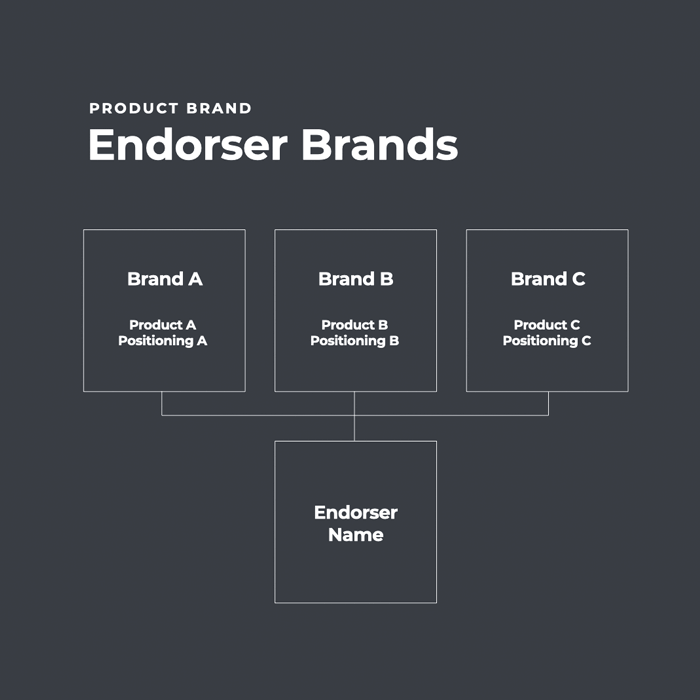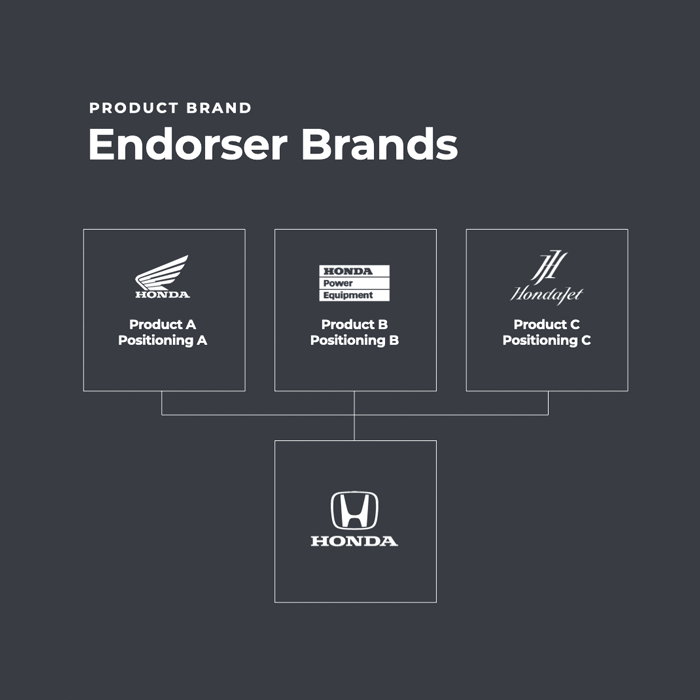Welcome to the fourth post in our series on brand architecture models. This article will explore the endorser brand architecture model—the third foundational brand model in our series—what it is, and why it matters.
Did you miss the previous articles in this series? Check them out by visiting:
Our next and final article in the series will unpack the source brand and hybrid brand models.
What is the endorser brand architecture model?
The endorser brand model is identified by several key characteristics. First and foremost, the parent company’s name is well-known and guarantees quality. That said, each product carries its own name coupled with a single positioning.
To make a finer point, each new product is a new brand with a unique stand-alone look and identity yet works in concert with the other brands. Most importantly, each brand has an inextricable tie back to the parent company name that, unlike the house of brands model, is largely front and center in the consumer’s mind.

Looking at Diagram 1, we see that the boxes representing the individual endorsed brands are interconnected (note the linear connectors), indicating a dependence on each other stemming from an even deeper dependence on the core endorsing brand.
Additionally, note that the core or parent brand is positioned beneath the brands it supports—in that they are largely dependent on its strong foundational value to consumers.
As a sort of all-for-one/one-for-all approach, the sub-brand’s value borrows heavily from the core or parent’s well-earned brand equity.
Each brand design and identity is distinct, representing a single product line and positioning, yet each is tied directly back to the endorser brand.

Why does the endorser brand architecture model matter?
Because an endorsing brand, like Honda, represents a significant brand trust with consumers. A trust that can be leveraged across sub-brand adjacencies.
Honda is a very strong and stable automobile manufacturer brand name. It presents a clear positioning and possesses oodles of brand equity earned over many decades of consistent delivery against its core benefits.
As an endorser model, unlike GM in our last article (see House of Brands), the name Honda is very well-known as a consumer brand. Their vehicle design focuses on safety, quality, and simplicity rather than flashy aesthetics, and the company is routinely ranked as one of the most reliable on the market—offering immense value to car buyers.
Honda’s reputation is so deep and well-known that consumers and industry experts alike often speak on the company’s behalf. It is common to hear someone say, “The engine in a Honda will easily last for 200,000 miles.” Brand value like that cannot be purchased but rather must be earned.
A closer look at Honda’s endorser brands
Recognizing this value, Honda built a suite of brands that borrow directly from Honda’s reliable name in mechanically-powered design, e.g.:
- Honda Motorcycles
- Honda Power Equipment
- Honda Racing
- Honda Jet
- Acura
Each Honda sub-brand product line features a unique brand identity with a unique positioning but never strays from the core strengths of the parent brand name (such as simplicity, safety, quality, and reliability). To emphasize this reliance, each brand name includes the word Honda in it. That is a simple and direct reference to what product is provided (jets, motorcycles, power equipment). That is each brand except one: Acura.
Honda felt it could expand and compete in the luxury car market. However, Honda’s simplicity, safety, quality, and reliability attributes—important as they are —are not strong leading points of value in the luxury automobile space.
Thus, the less descriptive Acura name was developed.
A closer look at the Acura endorser brand
The Acura brand name derives from the Latin Acu, meaning “done with precision” or “mechanically precise.” A clear but subtle tie back to the strength of Honda—simply elevated to a higher price point potential. Also of note is the Acura “A” logo mark, which is crafted from an inverted and pinched Honda “H.”
Honda has been successful because it is, above all, a company that focuses on doing one thing well—making engines that last a long time for cars, motorcycles, and so-called power products like lawn mowers, generators, snowblowers, and weed or garden trimmers.
Jeffrey Rothfeder, Driving Honda: Inside the World’s Most Innovative Car Company
Honda is endorsing and benefiting its grown-up luxury compatriot brand even in these nuanced ways.
When to use the endorser brand model
In short, the endorser brand model is great for parent companies that possess strong broad-based brand equity in their category:
- The parent company name is front-facing, well-respected, well-known, and guarantees quality
- One name is assigned to one product along with a single positioning and typically carries the parent company name as an identifying brand element
- Each new product is a new brand but works in concert with the other sub-brands yet tethers tightly to the parent brand’s known benefits and qualities
Other examples of endorser brands include:
- 3M
- Johnson & Johnson
- Courtyard by Marriott
- Polo by Ralph Lauren
How to create an endorser brand
As with all brand models, developing a sound and structured endorser brand architecture model requires strategic thinking and a focused approach. Here are a few tips along those lines.
Consider your market
As always, begin with a strategic look across your intended market. In our example, Honda saw a clear business path to developing and endorsing sub-brands built on Honda’s good name.
In each case, Honda was careful not to stray far from their strengths. Namely reliability, simplicity, and quality in mechanically powered products. A space they clearly understand.
Of course, Honda can stretch their brand equity to cover industries like dairy farming, SaaS (Software-as-a-Service) products, or home building. Instead, the Honda suite of sub-brands is directly tied back to Honda’s prowess, expertise, and unparalleled reliability in engine design—a much better endorsement bet and far less risky to the core Honda name brand.
Think about your audience
As always, each sub-brand in the endorser brand model must respect its audience’s wants/needs as well as have a solid product-market fit and business model of its own.
Though directly endorsed, the verbal and visual identity of each endorsed brand must stand on its own as well as pay homage to the parent brand.
“The main target audience of Cadillac is affluent millennials, people in their late 20s and early 30s who have adequate memory of Cadillac’s fall, rise and near-rise again.”
Aditya Shastri, IIDE – The Digital School
Extensive Marketing Strategy of Cadillac With Detailed Overview (2022)
Take into account your parent company’s brand
Perhaps like no other brand architecture model, endorsed sub-brands live and die on their parent company’s depth of awareness and the strength of its name as a guarantor of quality in the marketplace they operate within.
Ensure your sub-brands are in order
To be successful, all endorsed sub-brands must truly stand up to the qualities established by the core brand lest the integrity and market value of the brand at large (parent brand included) be harmed in any way.
FAQs about the endorser brand model
How does the endorser brand model affect a business overall?
High-value brand equity—particularly national or global—is difficult to build and maintain.
If a company can manage to attain that high value and manages to sustain it over long periods of time in the eyes of its consumers and stakeholders, then the opportunity to leverage that value across multiple adjacent brands may be plausible. This allows the core brand to expand into different markets and realize.
If the entire brand suite continues to deepen the positive reputation of the parent name in the consumer’s eyes, then the entire brand portfolio market value will increase. All of which can lead to word-of-mouth consumer endorsement and reduced marketing costs.
What benefit is there in considering an endorser brand architecture model over other options?
Like the house of brands, the endorser model allows each brand to stand on its profit and loss statement. Therefore, like the house of brands, each distinct brand can be assessed more clearly as to its value in its markets.
But unlike the house of brands model, the flywheel effect of the parent company’s brand value can serve to stabilize and lift the value of its namesake offspring.
Over time, those same sub-brands can also add to and strengthen the relative value of the endorsing parent company.
Is there a downside to an endorser brand model?
In that endorsed sub-brands typically carry the name of their parent brand, they are less likely to become a powerhouse brand in their own right. Each sub-brand generally requires its own executive team and all the support teams needed to create a new business in a niche category.
The endorsed brand model is a great framework for established brands that have largely done things right and built considerable brand equity in a given category. The endorser model is great for expanding into adjacent industries that are somewhat understood (think Honda “engines”).
As always, it is important to count the costs.
Typically, endorsed sub-brands will require separate executive teams and functional departments, new infrastructure costs, and go-to-market strategies.
